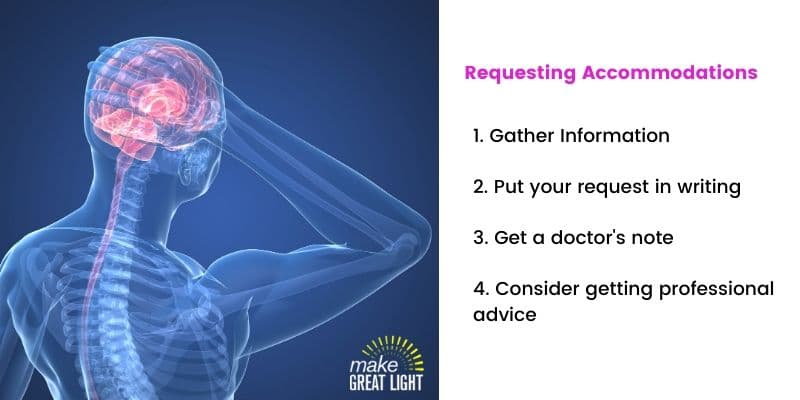Light sensitivity, or photophobia, often appears as a symptom for certain medical conditions. This can mean that you are sensitive to sunlight or bright lighting due to an underlying cause. This sensitivity can extend to certain types of lighting as well, like the fluorescent lights found in many workplaces.
What reasonable workplace accommodations are you entitled to?
Reviewed and updated for 2024 by Molly Duong, M.D.
While light sensitivity often affects the eyes initially, it can also extend to causing more severe symptoms throughout the body. For those with eye conditions, harsh fluorescent lights can cause eye pain and irritation. Furthermore, it can increase stress in people with autism spectrum disorders, trigger certain autoimmune conditions, and set off migraine attacks.
These conditions can quickly become debilitating and prevent workers from completing necessary tasks at work. However, conditions that cause light sensitivity are often invisible and thus not considered. Employees are forced to struggle with their symptoms, leading to an accumulation of absences, or even resignation.
Fighting through the symptoms of a serious condition isn’t the answer. Instead, ask your employer about accommodations that help you keep your symptoms under control and increase your productivity.
Why Should My Employer Provide Accommodations?

First and foremost, accommodations are protected under law. Title 1 of the Americans with Disabilities Act states that an employer must provide reasonable accommodation to qualified individuals with disabilities who are employees or applicants for employment, except when such accommodation would cause an undue hardship. The statement might seem vague, but it holds significant weight and enforcement.
- Reasonable accommodations: Include any changes to the application and hiring process, the way a job is done, or the workplace environment that allows a qualified employee with a disability to perform the essential functions of a job.
- Person with disabilities: Defined as someone with a physical or mental impairment that substantially limits one or more major life activities, a person who has a history or record of such an impairment, or a person perceived as having an impairment.
- Qualified individuals: Defined as a person who is able to perform essential job functions in a position. Additional determining factors may include the skill required and the number of other employees who can fulfill the same duty.
- Undue hardship: Any financially detrimental changes changes or changes that represent a direct threat to others.
Simply put, your employer must make reasonable changes to your workspace unless those changes are outside of what is financially reasonable, or poses any direct threats.
Are Migraines Covered Under ADA?
Migraines can be covered under ADA, but sometimes they aren’t. Surprisingly, there is some controversy surrounding this question. Since migraine symptoms and the triggers that set them off vary so widely, determining whether they fit the ADA definition of disability is a challenge. The ADA defines a disability as a physical or mental impairment that substantially limits one or more major life activities.
The Migraine Research Foundation describes migraines as “an extremely incapacitating collection of neurological symptoms … accompanied by one or more disabling symptoms.” Severe throbbing head pain, visual disturbances, nausea, vomiting, dizziness, and tingling or numbness in the extremities or face are all symptoms of migraines.
Additionally, extreme light sensitivity as well as sensitivities to sound, touch, and smell are frequently experienced as well. Often, these symptoms substantially impair your ability to work.
Unfortunately, migraines are considered an invisible condition. Employers who are in the dark about your condition have little to no knowledge of the effects of a migraine attack during the workday. Still, migraine sufferers who experience symptoms that impair their work are eligible for ADA accommodations.
Migraines and Employment Rights
Migraines affect more than 38 million people in the U.S. Still, many people who suffer from migraines experience discrimination at work. Migraine symptoms are widely misunderstood and devalued, mainly due to the fact that the symptoms are typically not visible to others.
Unfortunately, coworkers and employers often equate migraine symptoms to their own mild or moderate headaches. All too often, migraine sufferers feel like they’re lazy or weak because they cannot just “power through” the debilitating symptoms of an attack.
Here are a few truths about how migraines affect employees:
- Untreated migraine attacks force more than 90% of people with migraines to miss work.
- 63% of people with migraines suffer from at least one attack a month.
- 73% of migraine sufferers are women.
- 41% of women with migraines are more likely to suffer from depression.
- Migraine attacks are sometimes triggered by everyday occurrences such as a coworker’s perfume, fluorescent lights, or stress.
- 57% of accommodations for migraines don’t cost anything.
Accommodations for Light Sensitivity
Fluorescent lighting triggers migraine symptoms in several ways, as do LED lights. Though seemingly invisible to our eyes, fluorescent bulbs do produce a flickering effect. This effect, despite its subtlety, can trigger migraine symptoms. Additionally, harsh overhead fluorescent lighting can produce poor task lighting, leading to eye strain – another potential migraine trigger. Multiple areas of glare and unnatural bright lights can both provide overstimulation and set off a migraine attack.
Employers must accommodate the needs of employees and job applicants with a disability when doing so wouldn’t cause undue financial hardship. A variety of changes exist that help improve symptoms that are triggered by light sensitivity. Many of these changes only affect a small space within the building. Here are some of the most common accommodations for light sensitivity.
1. Alternate lighting options:
Many lighting choices in the workplace can trigger migraines. Fluorescent lighting has an almost imperceptible flicker that is a migraine trigger for many. Additionally, the bright, unnatural light creates glare that can further trigger symptoms as well. LEDs are a modern replacement, but often create harsh brightness that still increases glare. Light filters that prevent migraines, remove glare, and create full-spectrum light that mimics natural light. These filters are also inexpensive and installation is easy.
2. Flexible scheduling choices:
Unfortunately, migraine attacks often occur more than once a month for those who experience them. Flexible schedules can work in a variety of ways to allow migraine sufferers to make up for lost work time. Allowing employees to work in low-traffic hours (like evenings or weekends) can be an option. Additionally, you can implement scheduling choices such as unpaid time off, working remotely during attacks, or working part-time.
3. Anti-glare cover for monitors:
Office workers often spend hours in front of a computer. This intensity of light is a common migraine trigger. Anti-glare covers provide an inexpensive fix that eliminates this intensity, making viewing more comfortable for many.
4. Dress code changes:
Glare from overhead lights is a major problem in most workplaces. Therefore, consider allowing hats with wide brims and/or tinted glasses to be worn indoors as needed. This option can help eliminate the glare for those who are bothered by it to avoid triggering an attack, while not affecting others around them.
5. Dark-room:
A dimly lit, agreed-upon room provides a restful place for employees. Curb escalating migraine symptoms in a calm, dark room. Depending on the severity of symptoms, you can either continue working or take a short break to lie down to rest.
How to Request Workplace Accommodations
If you suffer from migraine attacks, create an open dialogue with your employer. First, understand that your employer likely has no knowledge of your debilitating symptoms. You are a qualified employee that your employer values, but you must take initiative to communicate these needs.
Simply sharing your history will get you one step closer to creating a healthier workspace. Take these steps to ask your employer about workplace accommodations to avoid triggers and relieve your migraine symptoms.

1. Gather Information
Learn about potential accommodations and how they may help you meet your job requirements. Determine what changes you need and be certain these changes will still allow you to complete the essential functions within your position.
2. Put your request in writing
This may not be required by your employer, but it can help you maintain documentation if you have difficulty getting the changes you need. Occasionally, it might be necessary to seek assistance from more than one person in your office. The presence of a paper trail helps speed up the process.
3. Get a doctor’s note
Proving your disability can be one of the biggest hurdles for migraine sufferers. Gather a documented history of your symptoms from a medical professional. With it, provide consistent information to your employer. It’s important that your employer understands how your symptoms affect your daily functions.
4. Consider getting professional advice
If you face difficulties when seeking accommodations, an attorney may be able to help. Unfortunately, the terms surrounding disability can be difficult to navigate when migraine symptoms are so diverse. An attorney helps you determine whether reasonable accommodations are something you are entitled to.
Migraine disease is a serious condition affecting millions of Americans in the workplace. Symptoms are often debilitating and make work functions impossible. Still, migraine sufferers are typically capable of being excellent employees under the right conditions. Furthermore, daily work triggers are often simple to eliminateProviding these simple steps can help many employees within your company and show that you support their professional success.
Workplace accommodations help employers retain valuable employees and make the workplace safer for those suffering from disabilities. For more information about how lighting affects various conditions and the changes you can make, see our NaturaLux light filter products.
Make Great Light is a company that specializes in the creation of light filters that block dangerous rays and remove harmful glare. Natural, healthy light in the workplace increases productivity and makes the space more comfortable and enjoyable for all.
About Dr. Molly Duong
Dr. Molly Duong is a therapeutic and glaucoma certified optometrist. She obtained her doctorate degree at the University of California Berkeley, School of Optometry, and graduated with Honors in Research. Upon graduation, she completed a residency at the Major Charles Robert Soltes Jr. Blind Rehabilitation Center located at VA Long Beach, gaining expertise in primary care, low vision, and traumatic brain injury cases.
She is passionate about expanding innovations in technology and medical devices to improve vision care, and is always looking to build her professional acumen. On top of patient care, she also works in medical writing for ophthalmic trade articles and blogs, as well as consulting for a new vision-based web application in development.
Citations and Sources:
1. https://www.eeoc.gov/policy/docs/accommodation.html
2. https://migraineresearchfoundation.org/about-migraine/what-is-migraine/
3. https://askjan.org/disabilities/Migraines.cfm/
4. https://migraineagain.com/migraine-and-work-understanding-your-legal-rights/
5. https://migraine.com/migraine-basics/ada-accommodations-the-workplace/

Why not mention their effects on epilepsy, Lupus, behavioral tendencies, etc. while you’re at it? From the annoying editor who left copy-edits on your video. Thanks for doing what you’re doing. No one thinks of this accommodation, though it can be so easy to remedy and improve the lives and the performance of so many workers and students. I have TLE and I repeatedly asked one client to move me from under a failing fluorescent light and they would not. This is the only contract I’ve edited/written for that wasn’t happy with me. They loved my work, but I had seizures so often, it decreased my productivity. It’s not just about empathy; it makes good sense. I have two decades of experience and I’m a damned good writer-editor…responding to they symptom (decreased performance) and not the cause (need to submit a work order to maintenance or a desk move) gave us both grief.
You might find my book useful. The focus is on Australia, but the issues are global. ” Light Sensitive Learners. Unveiling Policy Inaction, Marginalisation, Discrimination”.
This book is based on personal and professional experiences and PhD Research at the University of Sydney. Published in 2024
https://mybook.to/02Bv